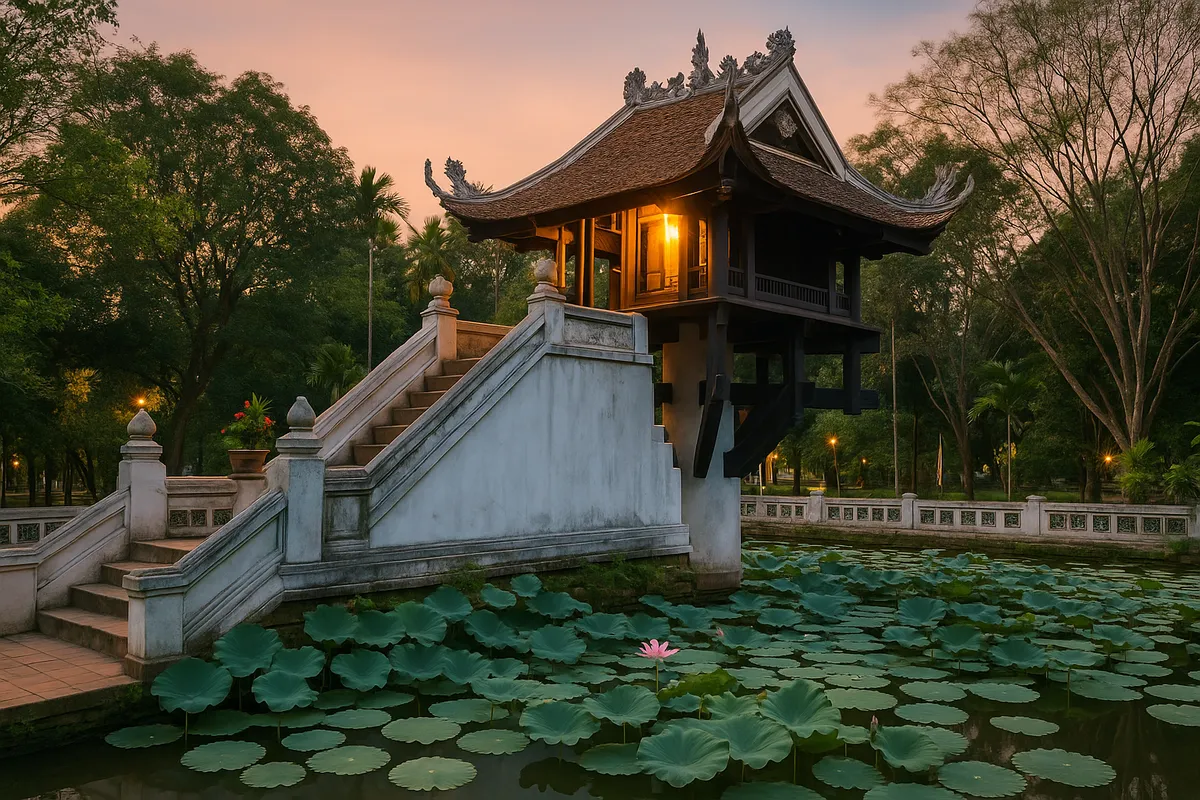How did One Pillar Pagoda disappear from Hanoi?
- Friday, Jun 06, 2025, 20:31 (GMT+7)
How did One Pillar Pagoda disappear from Hanoi?
Amid the bustling rhythm of Hanoi, where every street carries traces of time, a humble symbol rests quietly beneath ancient trees, as if it has never tried to attract attention. The One Pillar Pagoda (Chua Mot Cot) is not grand, not noisy, and does not display majestic statues or endless corridors. Yet with just a brief pause in front of the small pond where a wooden lotus rises into the air, anyone can feel as though they are touching a deep memory of this land.
According to legend, in the year 1049, Emperor Ly Thai Tong dreamt of the Bodhisattva Avalokiteshvara seated on a lotus flower, reaching out her hand to lift him. That dream was not only a spiritual mark for a king, but also gave birth to an extraordinary architectural symbol. A lotus pedestal was built entirely of wood, resting upon a single stone pillar at the center of a pond, appearing as a sacred object floating in space. The stone pillar stands over four meters tall without any complex reinforcement, yet it has remained firm for nearly a thousand years. The construction technique still amazes modern architects, but what truly silences the visitor is the philosophy behind it: a pure heart and a straight path to enlightenment.
Beyond the stone pillar and lotus platform, the site carries layers of meaning. A Bodhi tree by the pond was grafted from the sacred Bodhi tree in India, where the Buddha attained enlightenment. When the President of India visited Vietnam in 1958, he gifted this branch as a precious cultural and spiritual offering. Today, the tree still casts its shade, serving as a silent link between two ancient civilizations. Somewhere in the garden, a statue of President Ho Chi Minh sitting in quiet reflection creates a unique bridge between national spirit and Buddhist essence.
The main sanctuary is just over three square meters in size, so small that many may mistake it for a simple shrine. But inside, a jackfruit wood statue of Avalokiteshvara radiates an energy that is hard to explain. Her delicate face, half-closed eyes, and a smile that is almost not a smile convey a sense of boundless compassion. The wood is neither painted nor gilded. Everything is kept in its raw and natural form, yet it brings a strange sense of comfort to those who stand before it.
The layered two-tiered roof, commonly seen in large temples, appears on this modest lotus pedestal as an exceptional effort. The yin and yang tiles shimmer gently under sunlight, with roof edges curving like newly blooming lotus petals. No detail is excessive, and no element feels forced. Each curve and tile seems placed not by skilled hands but by the intuition of someone living within a dream.
In 1954, the One Pillar Pagoda was destroyed by explosives as the French army withdrew from Hanoi. The blast reduced the lotus structure to fragments, but it could not destroy the memory of the people. There were no architectural blueprints, only old black and white photographs from the Nguyen dynasty. Yet the structure was faithfully rebuilt as if no destruction had occurred. The true miracle was not in wood or stone, but in collective memory where strong faith was enough to restore what once seemed lost forever.
In the early morning, before the sun fully reaches the garden, the place is cloaked in a light mist. The pond reflects soft ripples beneath the lotus shrine. Leaves from the Bodhi tree hang gently, casting interwoven shadows and light like scenes from a slow-motion film. There are no bells and no heavy incense. Only wind, soft light, and a silence that touches every corner of the mind.
What makes the One Pillar Pagoda special is not grandeur or festive ceremonies but the smallest of details. Like the story of the sparrows that, for generations, found shelter beneath its roof tiles. The caretaker said that when the pagoda was destroyed, the birds disappeared. But when it was rebuilt, they returned, nesting on the same spots as if their memory had never faded.
There is one subtle fact that few notice. It is rare to see the One Pillar Pagoda fully lit by bright sunlight. Surrounded by large trees and low walls, the light only touches the rooftop, creating a soft and dreamlike glow like an ink wash painting. That may be why the most beautiful photos taken here are never dazzling, but always gentle, quiet, and timeless as if time has wrapped itself in wood and moss.
In the heart of modern Hanoi, where glass towers rise every day, the One Pillar Pagoda remains small yet quietly proud. It needs no signs, no colored lights, and no loudspeakers to invite visitors. Just one moment of stillness in front of the lotus pedestal in the pond is enough to let the heart drift with the gentle ripples and feel the weight of modern life melt away.
There are few places in the world where one square meter of space can evoke so many layers of emotion. The One Pillar Pagoda is one of those rare places. A symbol that does not need to be carved into stone to be remembered. A flame that needs no smoke to offer warmth. People do not come here for perfect photos or to beg for blessings. They come to listen. Even if only for a moment, to a story that began nearly a millennium ago.
If there comes a time when life feels too noisy, too fast, and your mind seems stretched thin by a thousand little things, try visiting the One Pillar Pagoda. Walk slowly. Look deeply. Stand completely still. Perhaps in that silence, you will finally hear yourself. And perhaps in that moment, you will understand that some things need not be grand or spoken. They only need to be present to move an entire lifetime.

 CHECKIN.VN
CHECKIN.VN








Share on